
Today is Feast of Saint Anne. Saint Anne, chosen by God to be the mother of Mary, His own Blessed Mother on earth, was the spouse of Saint Joachim.
Their lives were wholly occupied with prayer and good works. One thing only was wanting to their union — they were childless, and this was held as a bitter misfortune among the Jews. At length, when Anne was well advanced in age, Mary was born, the fruit rather of grace than of nature, and the child more of God than of man.
With the birth of Mary the holy matron began a new life; she watched Her every movement with reverent tenderness, and, aware of the little one’s destiny, felt herself hourly sanctified by the presence of her Immaculate Child. But she had vowed her daughter to God; to God the child Mary had already consecrated Herself, and to Him Anne gave Her back. Mary was three years old when Anne and Joachim led Her to the Temple steps, saw Her pass by Herself into the inner sanctuary, and then saw Her no more. Thus was Anne left childless in her old age, and deprived of her purest earthly joy. The holiest parents on earth could not, in the plan of God, raise this Child as was needed: Mary had to suffer from Her earliest years. Saint Anne and Saint Joachim humbly adored the Divine Will, and continued to watch and pray, until God called them to unending rest.
The Dignity and Sanctity of Saint Anne
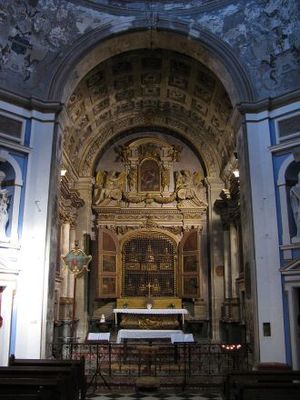
How holy must have been the woman in whom the great mystery of the Immaculate Conception was accomplished! How holy the womb into which the fullness of grace descended, in which the child “full of grace” was conceived and took flesh! Great was the dignity of St. Elizabeth, the mother of St. John the Baptist, who was privileged to have her son sanctified in her womb; but how much greater is the dignity of St. Anne, whose child, by a special prerogative, from the first instant of her conception was preserved from all taint of sin! Holy was the root from which sprouted the tree that bore the holiest Fruit, Jesus. St. Anne’s sanctity was increased still more through this wonderful conception: and indeed, how highly must she have been sanctified who bore the Mother of God!
Is it any wonder that St. Jerome praises her in the words: “Anne is the glorious tree from which bloomed a twig under Divine influence. She is the sublime heaven from whose heights the Star of the Sea neared its rising. She is the blessed barren woman, happy mother among mothers, from whose pure womb came forth the shining temple of God, the sanctuary of the Holy Ghost, the Mother of God!”
Yes, great indeed was the privilege and dignity conferred by God on St. Anne in electing her to be the mother of the treasury of all graces! How great must have been St. Anne’s joy, how blissful her delight, when, contrary to all hope, she gave birth to a child! And what a child! Never before had earth beheld a child so fair and noble as Anne’s infant daughter, “conceived without stain of Original Sin.” Never had there been a maternity so rich in blessings as hers — she who was privileged to call her child by the exalted title of “Mother of God.”
Well indeed might St. John Damascene, a great Doctor of the Church, exclaim: “Blessed, thrice blessed art thou, O Saint Anne, who didst receive from God and bring forth the blessed child from whom proceeded Christ, the Flower of life! We congratulate thee, O blessed Anne, on the dignity of being the mother of Mary, for thou hast brought forth our common hope, the germ of Promise! All pious lips bless thee in thy daughter, all languages glorify thy child! Worthy art thou above all praise, worthy of the praise of all who are redeemed, for thou hast given life to her who brought forth our Savior, Jesus Christ.”
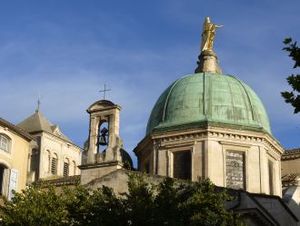
Even her name “Anne” signifies “gracious, loving” and typifies her sublime destiny. She too had been chosen by God from eternity, and to her, as to her daughter, Mary, may be applied the words: “The Lord possessed me in the beginning of His ways… I was set up from eternity.” [Prov. 8: 22-23] God prepared St. Anne with magnificent gifts and graces.
As the works of God are perfect, it was natural to expect that He should make St. Anne a worthy mother of that most pure creature who was superior in sanctity to all creatures and inferior only to God. Had St. Anne not been adorned with angelic purity, she could not have become the mother of the Virgin of virgins. The great miracle of Mary’s Immaculate Conception fittingly took place in St. Anne’s pure womb.
Miraculous discovery of relics
According to a most ancient and uninterrupted tradition, the body of St. Anne was carried to Gaul [a province of the Roman empire which included what are now the countries of France and upper Italy] by the same vessel which carried Lazarus and his sisters there. During the first century of the Christian era, these friends of Our Lord were banished from Palestine because of their faith. From their hands St. Anne’s precious remains were taken for safekeeping to the city of Apta Julia, which in our own times is the city of Apt, France. In those stormy days of persecution, it was necessary to hide the relics of the Martyrs and Saints.
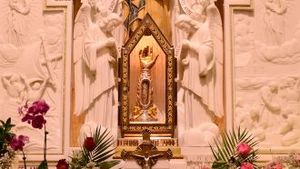
Consequently, the body of St. Anne was buried in an underground church or crypt. The martyrology of Apt, one of the most ancient in existence, mentions this fact.
The first bishop of Apta Julia, St. Auspicius, who died before 118, took further precautions to guard this holy treasure from desecration and had the body buried still deeper in the subterranean chapel. All approach to it was carefully concealed till persecutions and invasions should have ceased. For centuries, the country was repeatedly overrun by hordes of barbarians, and it was only natural that during these agitated years the precise spot where St. Auspicius had carefully hidden his treasure became lost in obscurity.
After Charlemagne’s decisive victory over the Saracens at the close of the eighth century, peace and security returned to Gaul. It was then that the people began to restore and rebuild the holy places destroyed or desecrated by the invaders. Priests and bishops of Apta Julia began to seek for the exact Spot in the deep crypt where St. Auspicius had hidden and walled up the sarcophagus of St. Anne.
Charlemagne’s first care on his arrival at Apt was to have the cathedral reconsecrated. This took place during the Easter solemnities, in the presence of an enormous crowd of nobles, clergy and people. But there was one cause of sadness amid all the rejoicing, namely, that every effort to find the remains of St. Anne had proved fruitless. A miracle, however, was to lead to the discovery of her resting place, as is related by Charlemagne in a letter to Pope Adrian I.
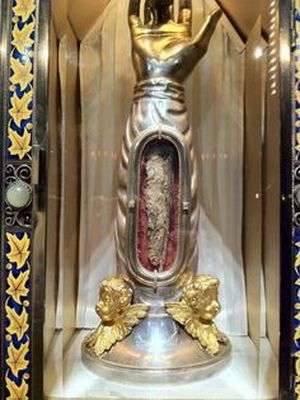
Among the young nobles who accompanied their parents on this occasion was John, a lad of fourteen, the son of Baron Casanova, deaf, dumb and blind from birth. People near the boy in the sanctuary remarked that during the services he was carried away by some overpowering emotion. With rapt and upturned face he seemed to be listening to voices from above. Presently, he moved toward the high altar, struck with his staff the steps leading up to it and made signs that they should dig there. His persistence caused considerable disturbance amid the solemn rites, but neither the clergy nor the royal guards could quiet or restrain the youth.
Charlemagne was deeply impressed. After Mass, he commanded that the excavation desired by the boy should be made. The altar steps were removed and a door, closed up with huge stones, was revealed. This was the door of the ancient crypt in which St. Auspicius had been accustomed to celebrate the holy Mysteries and to feed his flock with the Bread of Life. Its size and adornments reminded one of the Roman catacombs. No sooner had this door been opened and the flight of steps leading down from it disclosed than the blind boy rushed forward, as if his eyes had been suddenly opened, and led the way into this underground church. Charlemagne now held the boy’s hand and gave orders to keep back the excited multitude.
John made signs that they should search farther, and he struck the wall of the crypt, indicating that what they sought lay beyond. When the wall was broken down, another and lower crypt was discovered at the end of a long and narrow corridor. As they came in view of this crypt, a bright light flashed upon the Emperor and his assistants. They beheld, in front of a walled recess, a burning lamp, which flooded the place with unearthly splendor. No sooner, however, had the Emperor and his cortege entered this place, than the lamp went out. But, more wonderful still, at that very moment the blind boy could see, speak and hear. “The body of Saint Anne, mother of the Virgin Mary, Mother of God, is in yonder recess,” were his first words.
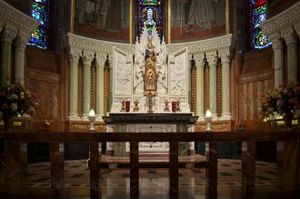
The awe-stricken Emperor and his followers, at first dumb with amazement, gave vent to their emotion in words of praise and thanksgiving. The walled recess was thrown open, a sweet fragrance like that of oriental balm filled the air, and a casket of cypress wood was discovered containing the body of St. Anne wrapped round and round with folds of precious cloth. On the casket was the inscription: “Here lies the body of Blessed Anne, mother of the Virgin Mary.”
Charlemagne, with all those present, venerated the sacred deposit thus brought to light. Afterward he had an exact narrative of the discovery drawn up by one of his notaries and a copy sent to the Pope with the royal letter. This letter and the Pope’s answer are still extant.
The miraculous discovery at once made the Cathedral of Apt the center of attraction for Christian pilgrims from every part of Gaul. In the wars which followed the reign of Charlemagne down to our own times, the clergy and people of Apt have watched with never failing love over the sacred treasure which is the glory of their city. Travelers visiting the venerable Cathedral of St. Auspicius will find piles of ex votos, the indisputable testimonies during eleven centuries of the wonders wrought there by Christ at the intercession of His sainted Grandmother. The chief cities of Gaul hastened to solicit from the church of Apta Julia portions of the hallowed body thus miraculously discovered. Fragments detached from the head found their way to various places through the favor of sovereigns or powerful prelates, but the greatest portion of St. Anne’s sacred body still reposes in Apt (France).

Vienna, Austria, possesses the right hand of St. Anne, which is devoutly venerated in the beautiful church which bears her name.
An arm of the Saint was solicited and obtained by the Popes and placed under the care of the Benedictine monks in the magnificent monastery church of St. Paul-Outside-the-Walls in Rome. In May, 1960, the Benedictines gave the forearm to the Shrine of St. Anne de Beaupré in Canada.
In the Cathedral of Bologna, Italy, a large portion of the Saint’s head is venerated.
Through these precious relics, which have proved efficacious in every kind of distress, miracles have been wrought — up to the present day.


